Organizational DNA (1:04)
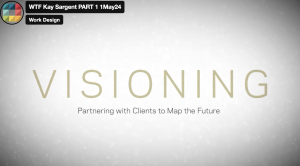 One of the things that we try to understand is what is their organizational DNA because if we understand that, then a lot of the answers become self-evident. So for what we believe are the six strands of that DNA, so the industry that you’re in and the regional influences. If you’re in Miami, it’s going to be different than London, than San Francisco. What are your demographics? Do you have a lot of retired individuals or people that are nearing retirement? Do you have a lot of individuals that are just entering the workforce? Kind of what’s the demographic, the work styles, the work culture, and then the organizational structure? And that’s important and it often gets overlooked because if you’re a very flat organization, then your workplace should also then reflect that. But if you’re a structured or hierarchial organization, then the workplace should reflect that to some degree.
One of the things that we try to understand is what is their organizational DNA because if we understand that, then a lot of the answers become self-evident. So for what we believe are the six strands of that DNA, so the industry that you’re in and the regional influences. If you’re in Miami, it’s going to be different than London, than San Francisco. What are your demographics? Do you have a lot of retired individuals or people that are nearing retirement? Do you have a lot of individuals that are just entering the workforce? Kind of what’s the demographic, the work styles, the work culture, and then the organizational structure? And that’s important and it often gets overlooked because if you’re a very flat organization, then your workplace should also then reflect that. But if you’re a structured or hierarchial organization, then the workplace should reflect that to some degree.
We used to go and do visioning sessions, so we’d come to you and say, what is it that you’re looking for? What do you want? Et cetera. And we kind of equate that to going to a doctor and the doctor looking at you and saying, well, what do you think you have? We have that expertise. And so our job is to really help them understand what’s even possible because most of our clients in our entire world has just been flipped totally upside down in the last three or four years. They don’t even know where they are. So when we go and ask them, where do you want to be? It’s like, I don’t know where I want to be, that’s why I’m coming to you. So we have these framing the possible discussions that really kind of help identify where are you now, where do you think you want to be, and what are the things that you may not be thinking about that you should be?
Hybrid is the Hardest (02:49)
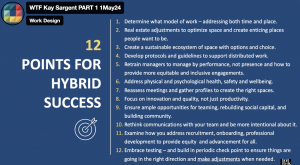 I think that most of our clients are asking us to help them create a workplace solution that will solve their hybrid problem or their return to office problem or the cultural issues that they might be challenged with today. But if you don’t have the policies and the procedures and you’re not retraining managers and onboarding people differently, then it’s going to probably really struggle to be successful because hybrid is the hardest model there is to pull off, but it’s also more of an operational model than a workplace solution. But everybody’s just looking at the workplace as kind of like that silver bullet that they’re hoping will solve their problems. And I think there’s a bigger play here as far as operational, but also even a cultural shift that we’ve gone under. And I don’t think most people are really truly paying attention to that. I don’t think most companies are putting in the hard work that they need to do to truly make hybrid successful. So they’re more likely to get it wrong than they are to get it right. And I think we’re going to be in this conundrum for the next several years as people try to figure out what is the right balance and how do we ultimately get to a point that everybody is satisfied with how we’re going forward.
I think that most of our clients are asking us to help them create a workplace solution that will solve their hybrid problem or their return to office problem or the cultural issues that they might be challenged with today. But if you don’t have the policies and the procedures and you’re not retraining managers and onboarding people differently, then it’s going to probably really struggle to be successful because hybrid is the hardest model there is to pull off, but it’s also more of an operational model than a workplace solution. But everybody’s just looking at the workplace as kind of like that silver bullet that they’re hoping will solve their problems. And I think there’s a bigger play here as far as operational, but also even a cultural shift that we’ve gone under. And I don’t think most people are really truly paying attention to that. I don’t think most companies are putting in the hard work that they need to do to truly make hybrid successful. So they’re more likely to get it wrong than they are to get it right. And I think we’re going to be in this conundrum for the next several years as people try to figure out what is the right balance and how do we ultimately get to a point that everybody is satisfied with how we’re going forward.
Flexibility of Time (04:09)
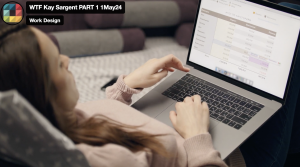
What we’re ignoring is that the commute is a big issue and that when we think about where people are working today, that’s kind of the question that we keep focusing on, but the studies are actually showing that more people care about when they work than where they work. So I don’t know a single company that when they told everybody they needed to go home for the pandemic, told them, and “by the way, while you’re working from home, just make up your own hours, do whatever you want”. But that’s actually kind of what people did. And people started to find their own rhythm and they realized, I’m either a morning person, I’m an afternoon person, I work better in spurts. I might want to get up at six o’clock and work for four or five hours and then take a break and then work for a few more hours later in the day, et cetera. And I think that when you’re calling people back into the office for that set amount of time that you’re supposed to be working diligently for eight hours straight, a lot of people just don’t function well in that mode. And so I think we’re actually ignoring our natural cycles and our natural rhythms and the fact that when you enable people to have some flexibility, it’s flexibility over time, that’s almost more important to them than where they actually are working.
Find the Right Balance (05:29)
 The huge issue is should we all be able to work from home or should we all be coming into the office? And many people have put it as a binary choice. It’s important to realize that because some people can work from home doesn’t mean everybody can. So we work for architectural firms and architectural practice is kind of like an apprenticeship model. You don’t know everything you need to know when you graduate from college. You need to spend some time sitting next, somebody who’s been detailing or designing or in the field or dealing with clients for a long time to really kind of continue that education. And a lot of professions are like that, but there are other professions that physical presence maybe isn’t as important. If you’re doing solo individual work or solo reports or processing things on your own, you may not necessarily need that.
The huge issue is should we all be able to work from home or should we all be coming into the office? And many people have put it as a binary choice. It’s important to realize that because some people can work from home doesn’t mean everybody can. So we work for architectural firms and architectural practice is kind of like an apprenticeship model. You don’t know everything you need to know when you graduate from college. You need to spend some time sitting next, somebody who’s been detailing or designing or in the field or dealing with clients for a long time to really kind of continue that education. And a lot of professions are like that, but there are other professions that physical presence maybe isn’t as important. If you’re doing solo individual work or solo reports or processing things on your own, you may not necessarily need that.
And so I think it’s important that we acknowledge that there are certain people that the benefit of being together is huge. And also we’re different personality types. There’s some people that just can’t work from home, they aren’t meant to, and other people that find it very distracting to be in a workplace. So what we have to do is find that right balance. And so for our organization, it’s being in the office three days a week and there are set days because if I’m coming in to be with my team, but that person isn’t there, then I could get incredibly frustrated that I’m coming, but you’re not. Or it’s also about core hours because we have people that are in the field that we need to answer to. So you can’t just make up your own hours if other people are reliant on you. So I had a client that framed this really, really well for me.
And he said internally what they’ve done is they basically have gone to their staff and said, okay, we’re going to give you some flexibility, but you need to think about number one, what does your job require you to do and where do you need to be to do your job? If you’re a lab worker or a restaurant person, you’ve got to physically be there. Okay. The second thing is, what do your clients need from you? The third is, what do your colleagues need from you? So we may not necessarily need to be in the office every single day, but other people might want us there so that we can be there for answer questions or to offer guidance. And quite frankly, maybe we need to be there so that we can pick up on some of the tips that the younger generation is bringing in and all the tools and the technology and the savvy that they have.
So what do our colleagues need from us? And then the last thing you should think about, what do you personally want? And I think unfortunately right now what’s happening is many people are waking up and saying, do I want to put on pants and drive to the office? No, they’re not thinking about, do my clients need me there? Do my colleagues need me to go to a meeting so that they don’t have to cover for me? Does somebody else need me to be able to be present to mentor people? So I think we have to be able to connect ourselves to something bigger than ourselves, and we’re not really doing that right now. We’re thinking very self, and I think we kind of need to get back to this group mentality of we all have jobs, we all have to support each other, there is a mission of that organization and to put those front and center.
Sustainable, Constant Improvement (08:51)
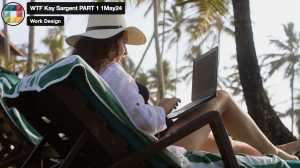 What’s happening now is that we’ve put the workforces in this extruded transition where we’re not really clear what the end game is going to be because we’re still kind of figuring that out. I think that transition and that unknown and that unstability is really left people feeling anxious and uncomfortable. But I also think that if you know you’re going to have to get upskilled or retrained because you will, to be able to have to stay current, then I think we need to think about do we create a system like they have in the educational world where you take breaks every six years, you take a sabbatical and you have to go learn something that’s beneficial for your job, but then you also have some time that you can go do whatever you want, whether it’s write a book, have a child, take care of a parent, travel, whatever that is, but you have those things that are baked in throughout your career so you’re guaranteed kind of this break. And if I know I’m going to be working for 50 or 60 years, but that every so many years I’m going to have a little bit of a buffer or break, okay, I can do that, that’s sustainable. But if there’s no break, then it’s not really sustainable.
What’s happening now is that we’ve put the workforces in this extruded transition where we’re not really clear what the end game is going to be because we’re still kind of figuring that out. I think that transition and that unknown and that unstability is really left people feeling anxious and uncomfortable. But I also think that if you know you’re going to have to get upskilled or retrained because you will, to be able to have to stay current, then I think we need to think about do we create a system like they have in the educational world where you take breaks every six years, you take a sabbatical and you have to go learn something that’s beneficial for your job, but then you also have some time that you can go do whatever you want, whether it’s write a book, have a child, take care of a parent, travel, whatever that is, but you have those things that are baked in throughout your career so you’re guaranteed kind of this break. And if I know I’m going to be working for 50 or 60 years, but that every so many years I’m going to have a little bit of a buffer or break, okay, I can do that, that’s sustainable. But if there’s no break, then it’s not really sustainable.
Design for Everyone (10:12)
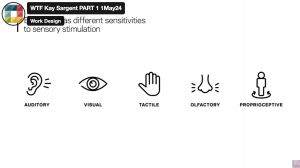 We know from all of the research that we’ve done and from post occupancy evaluations, that it’s sensory things that are challenging people, whether it’s lighting or acoustics or temperature, and that every single person in the built environment is being impacted by those. We are all constantly being assaulted by just the stimulation that is coming at us. And what might be irritating for me could be debilitating to somebody else. And so in our latest research around sensory processing and cognitive wellbeing and neuro inclusion, we pretty much have found that when you design for the extreme, you benefit the mean. Meaning, if I know what the triggers are and what the things in the built environment are that are setting people off, and I can address those in the workplace, every single person will benefit because we are all being impacted by the sound or the distractions or the disruptions or the temperature, all of those things in different ways, but every single one of those is impacting us. But if we don’t understand how the spaces we’re designing are impacting people, and it could negatively be impacting individuals. So we have to embrace the science of design to really understand how the spaces we are creating and the elements within them are impacting individuals in a positive and negative way so that we can create spaces that are more inclusive for everyone.
We know from all of the research that we’ve done and from post occupancy evaluations, that it’s sensory things that are challenging people, whether it’s lighting or acoustics or temperature, and that every single person in the built environment is being impacted by those. We are all constantly being assaulted by just the stimulation that is coming at us. And what might be irritating for me could be debilitating to somebody else. And so in our latest research around sensory processing and cognitive wellbeing and neuro inclusion, we pretty much have found that when you design for the extreme, you benefit the mean. Meaning, if I know what the triggers are and what the things in the built environment are that are setting people off, and I can address those in the workplace, every single person will benefit because we are all being impacted by the sound or the distractions or the disruptions or the temperature, all of those things in different ways, but every single one of those is impacting us. But if we don’t understand how the spaces we’re designing are impacting people, and it could negatively be impacting individuals. So we have to embrace the science of design to really understand how the spaces we are creating and the elements within them are impacting individuals in a positive and negative way so that we can create spaces that are more inclusive for everyone.

